If a process of evolution had really taken place on Earth, and had all living species actually descended from a single common ancestor, then some clear evidence of this would be discovered in the fossil record. The well-known French zoologist Pierre Grassé says this:
Naturalists must remember that the process of evolution is revealed only through fossil forms... only paleontology can provide them with the evidence of evolution and reveal its course or mechanisms.2
In order to see why this should be so, we need a brief look at the theory of evolution’s fundamental claim: that all living things are descended from one another. A living organism, which previously came into existence in a random manner, gradually turned into another, with all ensuing species coming into being—or evolving—that same way. According to this unscientific claim, all plants, animals, fungi and bacteria came into being in the same manner. The 100 or so different animal phyla (comprising such basic categories as mollusks, arthropods, worms and sponges) all descended from one single common ancestor. Again according to the theory, such invertebrates as these gradually, in the course of time and the pressure of natural selection, turned into fish, which turned into amphibians, which turned into reptiles. Some reptiles turned into birds, and others into mammals.
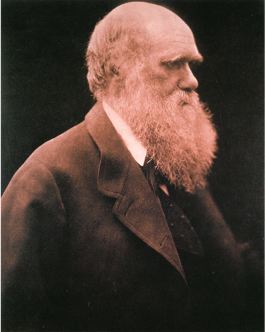 |
| Charles Darwin |
Evolutionary theory maintains that this transition took place gradually over hundreds of billions of years. That being the case, then countless numbers of transitional forms should have emerged and left some trace of their existence during the course of that immeasurably long period.
Half-fish, half-amphibian creatures, which still bore piscine characteristics despite having acquired four legs and lungs, should have lived in the past. Alternatively, reptile-birds that retained some reptilian features but had also acquired some avian ones must also have come into being. Since these species were part of a transitional process, they must also have been flawed, or even deformed. For instance, a transitional reptile’s front legs should have resembled bird’s wings a little more with every passing generation. But over the course of hundreds of generations, this creature will have neither completely functional front legs, nor completely functional wings—in other words it will exist in a flawed, handicapped form. These theoretical creatures which evolutionists believe to have lived in the past are known as transitional forms.
If creatures of that type really had existed in the distant past, then they must have been numbered in the millions, even in the billions, and their fossil remains should be excavated all over the world. Darwin accepted the logic of that, and himself stated why there should be a large number of transitional forms:
By the theory of natural selection all living species have been connected with the parent-species of each genus, by differences not greater than we see between the natural and domestic varieties of the same species at the present day; and these parent-species, now generally extinct, have in their turn been similarly connected with more ancient forms; and so on backwards, always converging to the common ancestor of each great class. 3
What Darwin is referring to is that no matter how little difference there may be among living species today—between a pedigreed German shepherd dog and a wolf, for example—, the difference among the ancestors and the descendants which are claimed to have followed one another, needs to be equally small.
For that reason, had evolution really taken place as stated by Darwin, then it would progress in very minute, gradual changes. Effective change in a living thing subjected to mutation would have to be very small. Millions of minute tiny changes would need to combine over millions of years for legs to turn into functional wings, gills into lungs able to breathe air, or fins into feet able to run on land. Yet such a process would have to give rise to millions of transitional forms. Darwin drew the following conclusion in the wake of his statement:
So that the number of intermediate and transitional links, between all living and extinct species, must have been inconceivably great.4
Darwin also expressed the same point in other parts of his book:
If my theory be true, numberless intermediate varieties, linking most closely all the species of the same group together, must assuredly have existed . . . Consequently evidence of their former existence could be found only amongst fossil remains, which are preserved, as we shall in a future chapter attempt to show, in an extremely imperfect and intermittent record.5
However, Darwin was well aware that no fossils of such transitional links had ever been discovered. This he regarded as a major stumbling block for his theory. Therefore, in the chapter “Difficulties of the Theory” in On The Origin of Species, he wrote the following: :
But just in proportion as this process of extermination has acted on an enormous scale, so must the number of intermediate varieties, which have formerly existed on the earth, be truly enormous. Why then is not every geological formation and every stratum full of such transitional forms? Geology assuredly does not reveal any such finely graduated organic chain; and this, perhaps, is the most obvious and gravest objection which can be urged against my theory.6
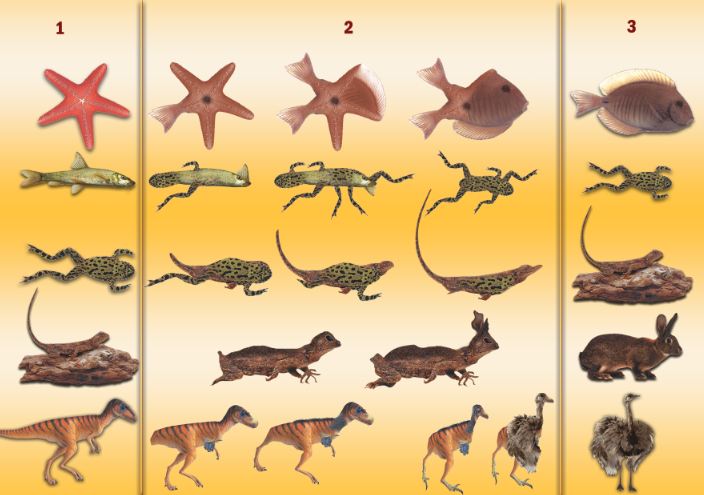 |
| 1. The fossils of perfect creatures If the theory of evolution were correct, then there should be fossils of strange creatures, half-formed and with features belonging to two different species, in the fossil record, of the kind depicted here. Yet not one such creature has ever been found in the record. |
In the face of this major dilemma, the only explanation Darwin put forward was the insufficiency of the fossil record of his time. He maintained that the missing transitional forms would inevitably appear once the fossil record was complete and was examined in detail.
However, fossil research of the last 150 years has revealed that the expectations of Darwin—and the evolutionists who followed him—were actually empty ones. Not a single fossil of any transitional form has ever been found. To date, there are around 100 million fossils, preserved in thousands of museums and collections. All of these are the remains of full-developed species with their own unique features, separated from all other species by definite, fixed characteristics. Fossils of half-fish, half-amphibians; half-dinosaur, half-birds, and half-ape, half-humans so confidently and definitely predicted by evolutionists, have never been encountered.
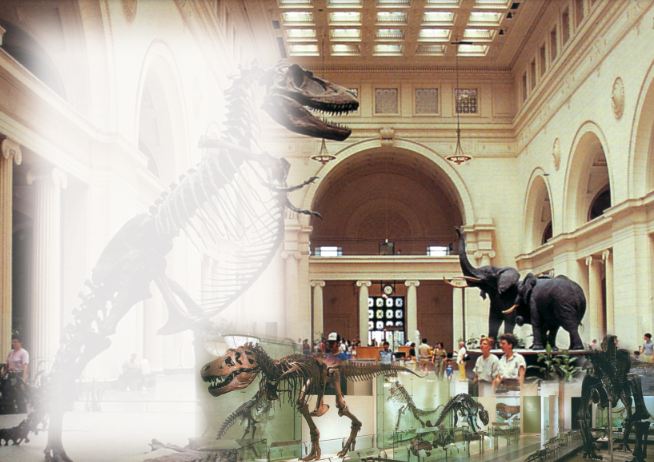 |
Despite being an evolutionist, Steven. M. Stanley of John Hopkins University admits as such:
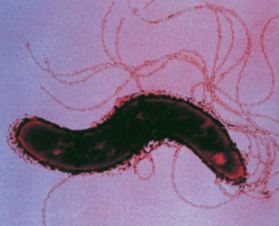 |
| |
The known fossil record is not, and never has been in accord with gradualism. . . Few modern paleontologist seem to have recognized that in the past century, as the biological historian William Coleman has recently written, 'The majority of paleontologists felt their evidence simply contradicted Darwin’s stress on minute, slow and cumulative changes leading to species transformation.' In the next chapter, I will describe not only what the fossils have to say, but why their story has been suppressed.7
Curators in the Department of Anthropology of the American Museum of Natural History in New York City, Ian Tattersall and Niles Eldredge describe how the fossil record contradicts the theory of evolution:
The record jumps, and all the evidence shows that the record is real: the gaps we see reflect real events in life’s history—not the artifact of a poor fossil record.8
As these evolutionist scientists state, the true history of life can be seen in the fossil record, but there are no transitional forms within that history.
Other scientists also admit the absence of transitional forms. Rudolf A. Raff, Director of the Indiana Molecular Biology Institute, and Thomas C. Kaufmann, Researcher at Indiana University, write:
The lack of ancestral or intermediate forms between fossil species is not a bizarre peculiarity of early metazoan history. Gaps are general and prevalent throughout the fossil record.9
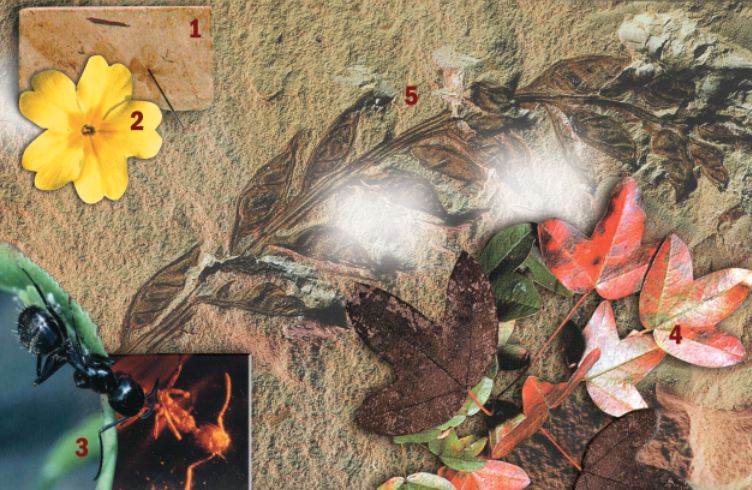 |
| 1: Right, a cowslip fossil. |
There are even preserved fossils of bacteria that lived billions of years ago. Nevertheless, it is striking that not a single fossil of any imaginary transitional form has ever been found. Fossils exist of a great many species, from bacteria to ants and from birds to flower-bearing plants. Even fossils of extinct species have been preserved so well that we are able to appreciate the kinds of structures possessed by these once-abundant species, which we have never seen alive. The absence of even a single transitional form within such rich fossil sources demonstrates not the insufficiency of the fossil record, but the invalidity of the theory of evolution.
2 Pierre P. Grassé, Evolution of Living Organisms, New York: Academic Press, 1977, p. 4. ![]()
3 Charles Darwin Op. cit., p. 281-283 ![]()
5 Ibid, p. 211 (emphasis added). ![]()
7 S. M. Stanley, The New Evolutionary Timetable: Fossils, Genes and the Origin of Species, New York: Basic Books, Inc., 1981, p. 71. ![]()
8 Niles Eldredge, Ian Tattersall, The Myths of Human Evolution, New York: Columbia University Press, 1982, p. 59. ![]()
9 R. A. Raff, T. C. Kaufman, Embryos, Genes and Evolution: The Developmental Genetic Basis of Evolutionary Change, IN: Indiana University Press, 1991, p. 34. ![]()